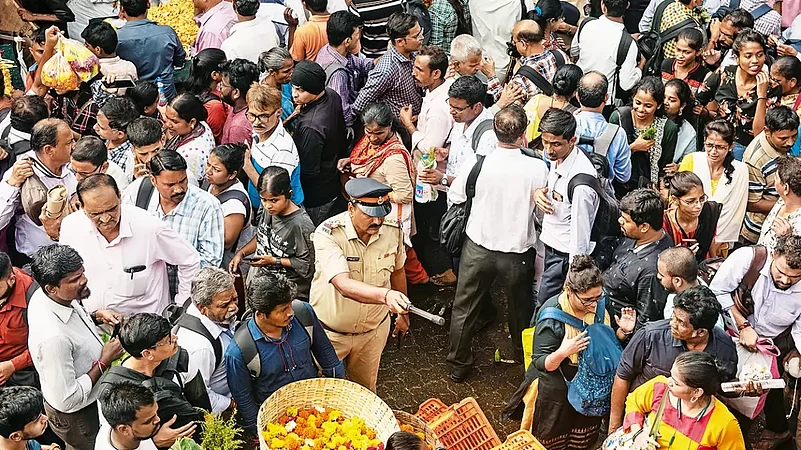Hand -washing with soap is a simple, powerful act that saves millions of lives in India and across the world. Hand hygiene prevents healthcare-associated infections (HAIs), which affect 15 out of 100 patients in low- and middle-income countries, killing one in 10 patients. Globally, approximately one in four hospital-treated sepsis cases and almost half of sepsis cases with organ dysfunction treated in adult intensive-care units are HAIs.
HAIs caused by inadequate hand hygiene are a major contributor to antimicrobial resistance (AMR), which occurs when mutations in bacteria reduce the efficacy of drugs. AMR is a growing crisis that, even before Covid, was projected to reduce GDP of low-income countries by 5%, and push 28 million into poverty by 2050. Handwashing with soap can reduce diarrhoeal diseases by 30%. It can reduce acute respiratory infections by up to 20%. It is linked to reduced rates of school and work absenteeism and is a core component of safe reopening strategies.
In India and across South-East Asia, the pandemic highlighted the importance of hand hygiene in keeping individuals and communities safe from infection and diseases and promoting health and well-being. Here, as elsewhere, tremendous energy was invested in establishing hand hygiene facilities in public spaces—at the entrance to buildings, transport hubs, markets and shops, places of worship and schools. Healthcare facilities from primary level upwards have increased infection prevention and control measures, in line with WHO recommendations and the ‘5 moments for hand hygiene’—before touching a patient, before performing a clean/aseptic procedure, after bodily fluid exposure risk, after touching a patient and after touching patient surroundings.
However, there are indications that hand hygiene is starting to decline. Several factors may be responsible.
In previous outbreaks, we saw that fear is a short-term motivator for behaviour change, and cannot be relied on for lasting population-level adaptations. Today, handwashing may be seen as less of a priority, especially given that adherence is not always visible. And as other preventive measures such as vaccination continue to be implemented, perceived risk may have decreased. Measures such as handwashing may be viewed as less important. But it is imperative that health and community leaders—and individuals—leverage this opportunity to sustain and accelerate momentum on hand hygiene.
First, policy makers have to focus on ensuring access to safe water, sanitation and hygiene (WASH). Globally, in 71 countries that provide data on WASH in healthcare facilities, 50% have basic water access and 74% have hand hygiene services at points of care. A global survey among more than million women and girls found that access to hygiene services was listed among the top ways of improving healthcare. In the 107 countries that have data on handwashing services in schools, 57% provide basic facilities and 25% have no services. This means that 818 million students have nowhere to wash their hands while at school.
In 2020, 71% people globally had access to basic handwashing facility, leaving 2.3 billion lacking basic services, including 670 million with no handwashing facilities. Globally, rates of change in access to handwashing facilities are slow, increasing by 4% between 2015 and 2020. What we need is a four-fold increase to meet Sustainable Development Goals (SDGs). Between 2015 and 2020, four countries in the region were among the fastest to increase coverage of basic hygiene, each achieving progress of more than five percentage points.
Next, behaviour change must continue to be a priority. It is not about providing right information; it is about influencing people. Efforts to promote hand hygiene have to be context specific, identify opportunities and barriers and create an enabling environment for people to adapt. They have to highlight new behaviour norms, and underscore the power of collective action, drawing on and celebrating the massive efforts made in recent times.
Third, governments need to increase investments in hand hygiene. Studies suggest that such investments generate savings that are, on average, 15 times the costs. In addition to direct costs—which can include medical treatment, out-of-pocket payments and travel costs for households seeking healthcare—poor hand hygiene has an array of indirect and avoidable costs like lost productivity and education, and tourism. Investing in hand hygiene is a ‘no-regrets’ investment.
To facilitate this, nations have to develop a strategic plan or roadmap that identifies targets aligned with SDGs. India is completing this process, building on the success of the Swachh Bharat Mission and other campaigns. Communities and NGOs need to increase advocacy, ensuring that policy makers are aware of health, social and economic impacts of hand hygiene, while building public support. Within WASH budgets, there has to be increased funding. At present, hygiene accounts for 4% of WASH budgets. This means that few countries have sufficient financial and human resources to implement hygiene policies and plans, with 9% reporting sufficient funds.
The Covid crisis demonstrated the centrality of health to social and economic development, which is dependent on building resilient systems that provide access without financial hardship—in other words, achieving universal health coverage. But it has underscored the urgent need to better manage the delicate relationship between people and planet, and to effectively address challenges at the critical interface between people and pathogens. Achieving universal hand hygiene will contribute to these outcomes and accelerate progress towards the flagship priorities and SDG targets. It will help fulfill the promise of Hand Hygiene for All Global Initiative, supported and launched in 2020 by WHO, UNICEF and other partners. Together, we must unite for universal hand hygiene to achieve a healthier, more resilient, productive and sustainable world.
***
818 million cannot access handwash facilities in schools globally
2.3 billion lack basic handwash amenities globally
















